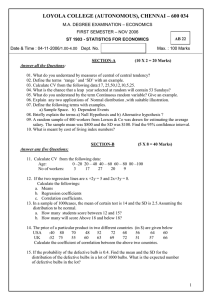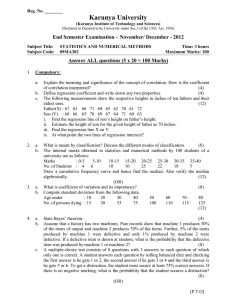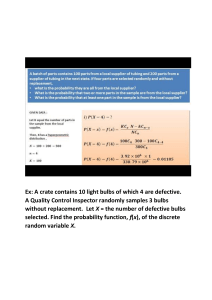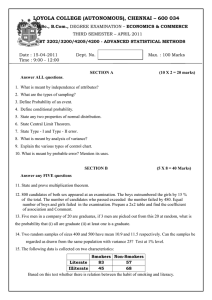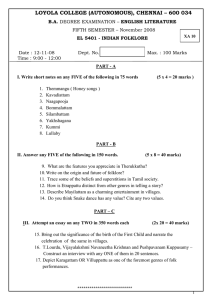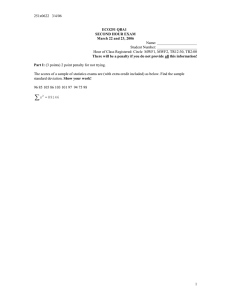LOYOLA COLLEGE (AUTONOMOUS), CHENNAI – 600 034
advertisement
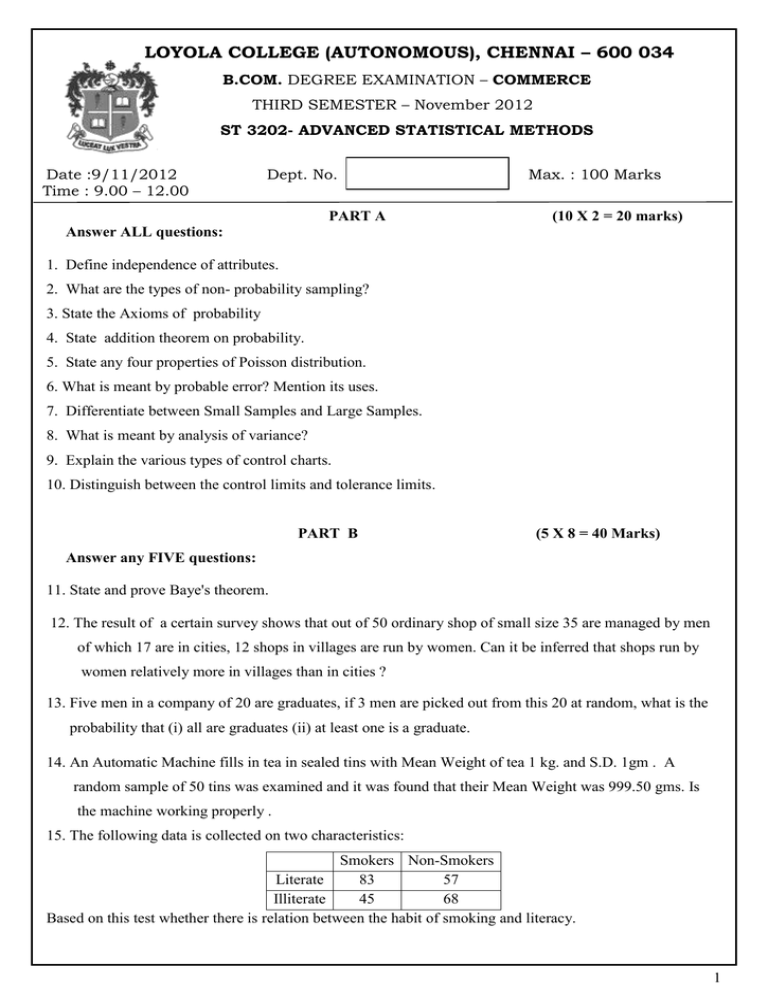
LOYOLA COLLEGE (AUTONOMOUS), CHENNAI – 600 034 B.COM. DEGREE EXAMINATION – COMMERCE THIRD SEMESTER – November 2012 ST 3202- ADVANCED STATISTICAL METHODS Date :9/11/2012 Time : 9.00 – 12.00 Dept. No. PART A Max. : 100 Marks (10 X 2 = 20 marks) Answer ALL questions: 1. Define independence of attributes. 2. What are the types of non- probability sampling? 3. State the Axioms of probability 4. State addition theorem on probability. 5. State any four properties of Poisson distribution. 6. What is meant by probable error? Mention its uses. 7. Differentiate between Small Samples and Large Samples. 8. What is meant by analysis of variance? 9. Explain the various types of control charts. 10. Distinguish between the control limits and tolerance limits. PART B (5 X 8 = 40 Marks) Answer any FIVE questions: 11. State and prove Baye's theorem. 12. The result of a certain survey shows that out of 50 ordinary shop of small size 35 are managed by men of which 17 are in cities, 12 shops in villages are run by women. Can it be inferred that shops run by women relatively more in villages than in cities ? 13. Five men in a company of 20 are graduates, if 3 men are picked out from this 20 at random, what is the probability that (i) all are graduates (ii) at least one is a graduate. 14. An Automatic Machine fills in tea in sealed tins with Mean Weight of tea 1 kg. and S.D. 1gm . A random sample of 50 tins was examined and it was found that their Mean Weight was 999.50 gms. Is the machine working properly . 15. The following data is collected on two characteristics: Smokers Non-Smokers Literate 83 57 Illiterate 45 68 Based on this test whether there is relation between the habit of smoking and literacy. 1 16 . An IQ test was administered to 5 persons before and after they were trained. The results are given below: Candidates I II III IV V IQ before training 110 120 123 132 125 IQ after training 120 118 125 136 121 Test whether there is any change in IQ after the training programme. Use 5% level of significance. 17. State the advantages and disadvantages of statistical quality control. 18. The following table gives the number of defective items found in 20 successive samples of 100 items each 2 6 2 4 4 15 0 4 10 18 2 4 6 4 8 0 2 2 4 0 Comment whether the process is under control. Suggest suitable control limits for the future. PART C (2 X 20 = 40 Marks) Answer any TWO questions 19.(a) A number of school-children were examined for the presence or absence of certain defects of which three chief descriptions were noted; A-development defects; B-nerve signs; C low nutrition. Given the following ultimate frequencies, find the frequencies of the classes defined by the presence of the defects. (ABC) = 57; (BC) = 78 (AB) = 281; (B) = 670 (AC) = 86; (C) = 65 (A) = 453; () = 8310 (10) 19 . (b) Two boxes contain 12 white and 18 black and 15 white and 25 black balls respectively. One box was taken at random and a ball was taken from the same. It is a black ball. What is the probability that it is from the (i) first box (ii) second box. (10) 20. (a) If 3% of the electric bulbs manufactured by a company are defective, find the probability that in a sample of 100 bulbs exactly five bulbs are defective (e-3 = 0.0498). (10) 20. (b) The average daily sales of 500 branch offices was Rs.150,000 and the standard deviation Rs.15,000. Assuming the distribution to be normal, find how many branches have sales between (i) Rs. 1,20,000 and Rs.1,45,000 (ii) RS.1,40,000 and Rs.1,60,000 (10) . 21.(a) The sales manager of a large company conducted a sample survey in states A and B taking 400 Samples in each case. The results were as follow State A State B Average sales Rs.2500 Rs.2200 Standard Deviation Rs.400 Rs.550 Test whether the average sales is the same in the two states. Test at 1% level. (10) 2 21. (b) Value of a Variety in two samples are given below: Sample I Sample II 5 2 6 3 8 6 1 8 12 1 4 10 3 2 9 8 6 * 10 * Test the significance of the difference between the two sample means. (10) 22. The following table gives the fields of 15 samples of plot under three varieties of seed. A 20 21 23 16 20 B 18 20 17 15 25 C 25 28 22 28 32 (20) Test using analysis of variance whether there is a significant difference in the average yield of seeds **************** 3
